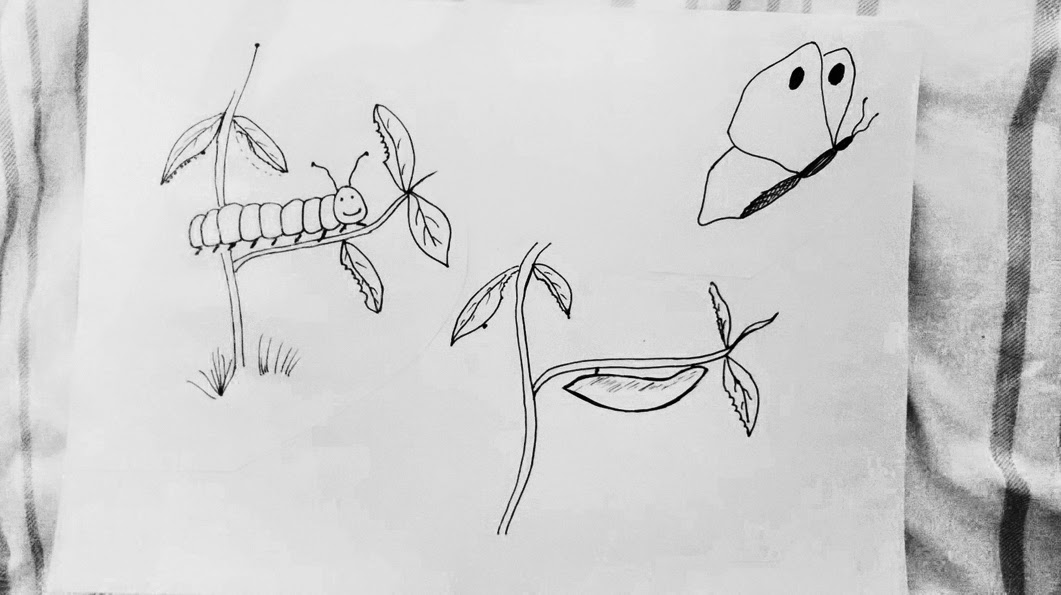Butterflies,
Stories, Change, Jazz
Rachel
Burnham writes: Ever since I saw a wonderful photograph of a
butterfly taken by Doug Shaw at the weekend and was in turn encouraged by him
to photograph the ones at our allotment, I can’t get butterflies out of my
mind. Their wonderful flowing shapes,
the variety of colours and patterns, the way they move, the contrasting
textures between wings and body.
Butterflies on the brain!
And of course, it isn’t just their shape that inspires
and entrances – they are so evocative in the way they represent ideas of
change, personal growth and transformation.
It is easy to connect with butterflies – many of us will have as
children folded a sheet of paper in two, placed splodges of paint and amazingly
a butterfly emerged. Or again folded a paper in two and cut shapes out to
create an outline of a butterfly. Some
of us may have repeated the process with our own children. You, like me, may
even have studied the life cycle of the butterfly in Biology lessons.
I have my own butterfly story. Many years ago, I represented the United
Reformed Church at the Assembly of the World Council of Churches – it was a
wonderful experience. One of the things
I remember from it was a huge artwork that hung at the back of the Assembly
hall – it was an enormous patchwork made up of many, many pieces each made by a
different church congregation in the host country, all illustrating the theme
of the event. At the close of the
Council, the pieces were all untied and each one given to a delegate to take
back to their own church. My piece for
my then church at High Cross, Tottenham was a beautifully appliqued butterfly –
in this case representing ‘New Life’ or ‘New Beginnings’.
My three part drawing of this life cycle tells a
story. But looking at it now I can see
many stories within it.
It could be the story of the many CLDP students that I
work with. Coming to the programme
hungry for knowledge, development and keen to develop their skills. The pupa could be the reflection that they
engage with during the programme. And I
certainly know many butterflies who have emerged & stretched their wings to
go off and explore the world of L&D.
I am lucky to hear from many ex-students who continue to stay in contact
and share their stories with me.
The butterfly’s story could be another way of looking at
Harold Jarche’s Seek-Sense-Share model for PKM (Personal Knowledge
Mastery). The caterpillar is clearly in
full ‘seek’ mode – curious & hungry - eating its way through all sorts of
interesting blogs, tweets, posts, shares and likes. Whilst in its cocoon, the pupa ‘senses’,
filters, combines, contrasts, discerns before emerging to ‘share’ its unique
wing patterns and take on the world.
Or it could be the story of my career – a keen &
eager young L&Der devouring books, trying out new approaches – a very
hungry caterpillar! Then feeling cocooned by the experience of motherhood and
that desperate need to balance out competing priorities – safety, the need to
earn and a limiting of professional challenges winning out. But now – a new phase is entered on and I’m
getting to spread my wings again!
What stories do you see in the butterfly’s experience?
Which brings me to jazz! Some years ago, I borrowed Toni
Morrison’s novel ‘Jazz’ from my brother.
I thought it was going to be about jazz.
Then part way through, I had a Homer Simpson moment ‘Duh!’ – it wasn’t
about jazz – it was jazz! Toni Morrison
had structured the novel just like a piece of jazz music, with the opening
chapter providing an outline of the main elements of the story – the ‘head
arrangement’ or ‘theme’ and then each subsequent chapter elaborating &
improvising on this theme from the perspective of each of the key characters –
a trumpet solo, sax solo, even the dreaded drum solo – if you like. Just like with a piece of jazz music, we all
have our own interpretations of our experiences or stories – sometimes we share
an experience with friends, but still have our own perception of that
story.
That happened to me only this week. In the course of a conversation, I suddenly
felt the ground shift, bit like a minor shock from an earth tremor, as I
suddenly shifted perspective and caught a glimpse of the world from another’s
perspective. A whole different story to
mine. Just for an instance.
And as I reflected on this, I was able to see
a new story for me. I had been telling
myself the story of my last few months in a particular way – with a particular
narrative theme – it’s been a tough 18 months personally - but I could now hear
it in a new way too. A more resourceful,
positive way. Like a jazz musician returning to a classic tune and finding new
patterns, new depths, new ways of playing it.
Like jazz musicians, we don’t have to play the same tunes
in the same way – it is possible to do differently, improvise and hear fresh
sounds. We write our own music.
Butterflies.
Stories. Change. And jazz!
Rachel
Burnham
23
July 2014
Burnham L & D Consultancy helps L&D
professionals become even more effective.
I am particularly interested in blended learning, the uses of social
media for learning, evaluation and anything that improves the impact of
learning on performance.
Follow me on Twitter @BurnhamLandD

